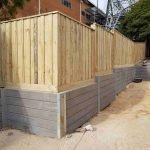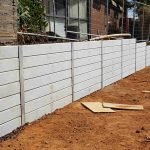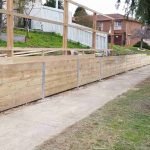Introduction
Retaining walls are more than simple structures; they embody the artistry of engineering and design. When we consider transforming our landscapes, keeping walls often work as pivotal components that not just support the ground but likewise improve the visual appeal of our backyards. The journey from a preliminary idea to a beautifully built retaining wall can be daunting. However, with the ideal proficiency and imagination from professional builders, this vision can flawlessly become reality. In this substantial guide, we'll check out every aspect of working with creative retaining wall builders, diving deep into materials like timber sleeper, concrete sleeper, and H beam constructions.

From Vision to Truth: Working with Creative Retaining Wall Builders
What Are Keeping Walls?
Retaining walls are structures designed to hold back soil and avoid erosion. They have a range of applications, from landscaping aesthetic appeals to essential structural stability in uneven surfaces. These walls can be made from different materials consisting of concrete, lumber, stone, and even gabions.
Why Pick Imaginative Retaining Wall Builders?
When it concerns building a retaining wall, choosing the right home builder is essential. An imaginative home builder does not just concentrate on functionality; they likewise think about how the structure will mix with your landscape. This ensures that your vision is not only understood but elevated.

Understanding Different Types of Retaining Walls
Gravity Walls
Gravity walls depend on their weight to withstand soil pressure. Usually made from heavy products like concrete or stone, these walls are straightforward however need significant space.
Cantilever Walls
These walls use leverage for stability. They are generally made from strengthened concrete and work well for taller structures.
Anchored Walls
For scenarios where extra assistance is needed, anchored walls are ideal. They use cable televisions or rods anchored into the earth behind them to supply additional resistance.
Materials Used in Retaining Wall Construction
Timber Sleeper Walls
Timber sleeper retaining walls use a rustic beauty and are ideal for garden landscapes. Their natural appearance blends magnificently with outside settings.
- Advantages: Budget friendly and simple to install. Disadvantages: Susceptible to rot if not dealt with properly.
Concrete Sleeper Walls
Concrete sleeper walls provide toughness and strength. These precast panels can be found in numerous designs and colors, enabling customization.
- Advantages: Lasting and low maintenance. Disadvantages: Higher upfront cost compared to timber.
H Beam Walls
H beam keeping walls combine modern-day engineering with visual appeal. H beams supply excellent stability while enabling imaginative designs.
- Advantages: Stronger than conventional materials. Disadvantages: Requires professional installation due to complexity.
The Design Process: From Concept to Implementation
Initial Assessment with Your Builder
The first step in building your retaining wall includes an initial consultation where you share your vision. This is where innovative home builders shine; they'll listen carefully to your ideas and suggest practical solutions based upon their experience.
Site Evaluation and Recommendations
A professional contractor will perform a comprehensive site evaluation before any building and construction begins. They'll evaluate soil conditions, drainage patterns, and other factors that could affect the project's success.

Designing Your Keeping Wall
Once assessment details are gathered, the style phase begins. Anticipate conversations around material options-- whether you prefer lumber sleepers for a rustic look or concrete sleepers for sturdiness-- and how these options will impact both budget and aesthetics.
Building Regulations and Permits
Understanding Local Building Codes
Before construction begins, it's important to comprehend regional building regulations regarding retaining wall construction. Many locations have particular regulations concerning height limitations, problem requirements from property lines, and drainages systems.
Acquiring Essential Permits
Professional home builders generally manage permits as part of their service bundle. However, it's still great practice for property owners to acquaint themselves with what authorizations may be needed for their project.
Construction Phase: Bringing Your Vision to Life
Preparing the Site
This includes cleaning plant life and particles from the construction location while ensuring very little interruption to surrounding environments-- a vital phase dealt with effectively by expert builders.
Foundation Work
A solid structure is crucial when constructing any retaining wall type; this step differs based upon picked products (concrete sleepers versus wood). Builders guarantee that footings fulfill engineering requirements before advancing further.
Wall Assembly Techniques
Different approaches apply depending on product choice:
- For timber sleepers: Appropriate anchoring methods need to be used. For concrete sleepers: Installation requires raising devices due to weight. H beam installation demands exact alignment for structural integrity.
Finishing Touches That Make a Difference
Landscaping Around Your Keeping Wall
After building is total, think about landscaping choices around your brand-new wall. Plants can soften its appearance while improving drain-- developing an inviting environment in your yard!
Maintenance Tips for Longevity
To guarantee your retaining wall lasts through seasons:
Regularly examine for fractures or signs of wear. Clean any particles build-up around drain areas. Add soil or mulch occasionally as needed for stability against erosion pressures over time.FAQs About Dealing with Creative Retaining Wall Builders
What Is The Typical Expense Of Building A Maintaining Wall?
Costs can http://beaufence-installerczex638.huicopper.com/melbourne-s-best-retaining-wall-builders-what-sets-them-apart vary substantially based on materials utilized (timber vs concrete) together with style intricacies-- normally ranging from $15-$50 per square foot depending mainly upon regional labor expenses as well!
How Long Will It Require To Build A Retaining Wall?
Typically speaking-- most projects take anywhere between 1 week-- 1 month depending on size/scope involved! Bigger projects require more time due too additional preparations needed in advance so constantly consult directly!
Can I Build My Own Retaining Wall?
While DIY choices exist particularly using lighter products like lumbers-- more complicated structures require specialists experienced in structural engineering finest practices ensuring safety & & durability throughout lifespan!
What Maintenance Does A Timber Sleeper Wall Require?
Timber sleeper walls require routine examination specifically after heavy rains or snowmelt durations checking footing stability & & treating wood surfaces against rot/mold buildup stays important maintenance aspects!
Are There Eco-Friendly Options For Building A Retaining Wall?
Yes! Many business now provide recycled products as alternatives consisting of recovered wood products alongside sustainable sourcing practices promoting greener structure approaches overall!
Conclusion
Transforming your landscape through a perfectly constructed retaining wall does not have to be frustrating when you work with competent specialists who appreciate both creative style principles together with technical know-how! By understanding various types-- from wood sleepers & & concrete options right down through innovative h beam services-- you'll find exactly what matches finest within tailored visions turning dreams into concrete truths! So why wait? Begin checking out how creative retaining wall home builders can help bring YOUR special outdoor aspirations alive today!